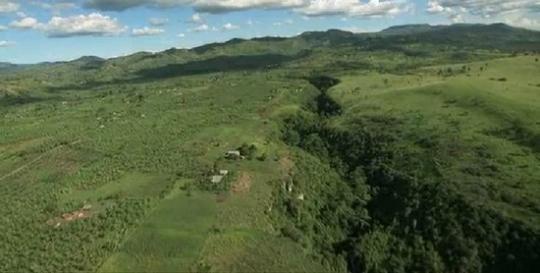

There was this article in the Newvision today: “Parents whose baby was injured by chimpanzee demand sh300m”
Excerpts:
The Parents of the eight months old baby recently injured by an irate chimpanzee are demanding sh300m from Uganda Wild Life Authority (UWA) a government agency mandated to manage and conserve wildlife.
Medics at the hospital said the operation was necessary because, the baby’s tendon jaw had been hurt by the chimpanzee.
Asiimwe was snatched from mother’s back as she chased monkeys from a maize garden in Mparangasi village in Kyabigambire sub county Hoima district in June.
The baby that was bleeding profusely with a deep wound on the right heel was retrieved by residents who located the chimpanzee in the forest.
Kiiza and Kaahwa in the August 8 notice said the chimpanzee bit off the heel of their daughter who was later admitted in hospital for a month.
That is a sad story and I hope appropriate action will be taken to help the child and address the problem in the area.
It would however help if the Newvision reporters in the first report checked their facts before reporting. The picture shown at least is NOT of a chimpanzee but of BABOON mother with her young. [The picture in the article was apparently later changed to that of a chimpanzee]
Whereas chimpanzees in Uganda are found only in the south west, (not sure about Murchison Falls N.P, but probably none there – a simple check in Wikipedia & other documentation can help or even with the UWA), baboons are found in a good bit of the rest of the country and anyone travelling to the east and passed through Busitema forest has probably seen groups crossing the road.
I remember a friend one time referring to these as “gorillas” and refusing to accept correction. Gorillas in Uganda are found exclusively in Bwindi Impenetrable National Park & Mgahinga, none elsewhere.
There are lots of types of monkeys elsewhere, though in some areas like many parts of Bugisu, almost none are left except may be in the high uninhabited regions, because of the expansion of human settlement and its high density.
So the question we should ask is: what animal injured the kid, an irate chimpanzee or baboon? The 2 are VERY different animals.
Then there was this headline today “Elephant kills cyclist at Karuma“. Apparently, the cyclist sped into a group of elephants being chased by villagers from their farms.
The chief warden of Murchison Falls National Game Park, Tom Okello told the New Vision on Tuesday that Okello was riding at high speed when he knocked the elephants and died.
“The man came at a breakneck speed and knocked the elephant that was crossing the road as the community chased it away from their gardens. We have had the elephants crossing into people’s gardens at night,”
I think one of the problems in Uganda is the currently probably highest population growth rate in the world of ca 3.5%/p.a. [one should look into this & its far-reaching consequences on the environment and the economy] which has meant human settlements taking up more and more of the lands in the natural habitats of these animals. They have increasingly been confined to smaller and smaller regions meaning clashes with humans because of straying into their settlements while looking for food are set to become more and more inevitable and frequent. Through activities like cutting down trees for farming, firewood & the like, also means taking away the cover and fruit & other plants these animals depend on. Immigration routes have been cut or destroyed. The other day, I was watching a BBC animal documentary [BBC Natural World – Chimps of the Lost Gorge [HD] – Update: 01.2015 – Video removed :(] showing how some chimps have been trapped in a gorge cut off from the rest in 2 neighbouring forests through human influence and its dramatic impact on them. In the past, these 3 areas were not separated. These types of conflicts are bound to continue!
These animals mostly try to avoid humans, who are not considered to be the best of friends. In this case may be it saw what it considered its “territory” being encroached on. Many animals are territorial & it could have seen those people as rivals posing a danger to its food or mates or may be some had young around and felt threatened. That is a natural reaction. That is why people have guards or dogs to keep their premises!
Otherwise some apes, including chimpanzees are known to attack others, in the case of chimpanzees, mostly smaller monkeys BUT ONLY ONCE IN A WHILE, for example colobus monkeys for some rare protein, because they are known to be vegetarians. This VERY rare venture however is not done by single animals but by a group. So I think we can rule that out in the above case. BBC & other TV documentaries are a good source of knowledge about this.
Baboons mostly eat plant material, but do not mind insects and other small animals, though now and then, especially the bigger males catch and eat smaller animals. They mostly avoid humans and indeed other animals they judge to be (potential) enemies, but if they feel threatened, normally the males in a group can get quite tough and have been known to challenge and even chase away attackers like leopards or cheetahs. There is a lot of documentation on this. A shot clip showing “Baboons on the Nile, Uganda, May 2012“: On Youtube.
In the case of the elephants, again it seems to be the same thing. This poor motorcyclist happened to be in a the wrong place at that time. The elephants were being chased by villagers after they crossed over from the neighboring park and raided their gardens. Whereas fencing off the park to keep animals away could help and probably bring temporary relief, in the long term this problem of park animals “raiding” villages/crops, like it gets reported every now and then is bound to continue.
Just like it has been mentioned on this site in other contexts, the underlying issue here ultimately is the too rapid expansion of the population in spite of AIDS especially in the late 80s & early 90s (which killed a good number of people) in the last 30 or so years, where it grew from around 7m in the 60s, to 9.5 million (1969 census – Uganda Bureau of Statistics) to the current 35,873,253 (July 2012 est. – source World Factbook) with far reaching consequences for the environment and the economy in spite of statements contrary to this from some officials who imply the high population is good for th economy. That might be true, but its rate of growth is not matching the growth rate of the economy. People should ask themselves in spite of the respectable growth rate of the last 20 years, leading to a considerable increase of GDP, why the average income has not changed much and the country on the world scale has not moved up much. There is a direct connection between the 2 issues. In densely populated areas, though, like Bugisu, we have seen other fatal environmental consequences of too high/rapid population growth, mentioned below.
Other articles of interest:
- The recurring problem of mudslides in Bududa and the Uganda government’s role
- What can be done to eventually stop the recurring mudslides in Bududa, whose frequency and fatality is increasing?
- A beautiful documentary about Brutus and other chimps in the Kyambura Gorge and its sad lessons
